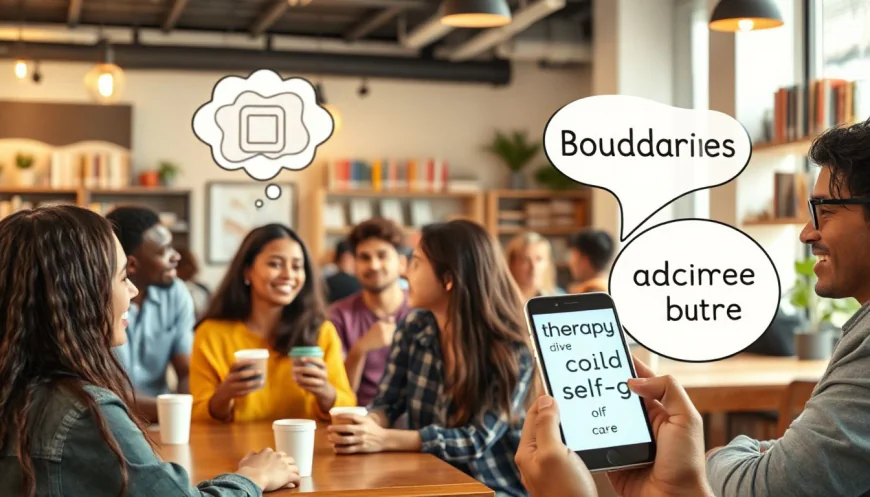The Rise of Therapy Speak in Everyday Language: Understanding Its Impact and Significance
In recent years, mental health awareness has grown faster than ever. People are talking about feelings, healing, and inner peace more openly. This shift has led to a flood of therapy-related words showing up in everything from social media posts to casual chats. Terms like "trauma," "boundaries," and "gaslighting" have moved from therapist offices to the headlines and memes we see daily. This change isn’t just vocabulary; it shapes how we understand ourselves and others. Knowing how therapy speak influences our society helps us communicate better and reduce mental health stigma.

The Evolution of Therapy Speak in Pop Culture
How Therapy Terms Enter Mainstream Media
TV shows, podcasts, and social media have played key roles in normalizing therapy language. Shows like Grey’s Anatomy or Insecure often explore topics like emotional boundaries or past trauma, making these ideas familiar. Podcasts dedicated to mental health, such as Therapy for Black Girls or The Hilarious World of Depression, introduce these terms to wide audiences. Social media, especially TikTok and Instagram, makes mental health phrases viral, turning them into trending hashtags or meme captions. Suddenly, talking about “boundaries” or “self-care” feels natural, even in a joke.
The Influence of Celebrity Endorsements
When stars openly share their therapy journeys, it makes these topics less taboo. Celebrities like Selena Gomez or Prince Harry talk about their mental health struggles, often using therapy words. Their openness encourages fans to do the same and accept these terms as part of everyday life. Celebrity endorsements shape public opinions, making therapy language more acceptable and relatable.
The Role of Social Media in Spreading Therapy Speak
Platforms like TikTok and Twitter spread therapy-related terms at lightning speed. Trends often include catchy phrases like “setting boundaries” or “self-love.” Many videos feature quick tips about managing anxieties or recognizing gaslighting behaviors. This meme culture makes complex mental health concepts easy and quick to understand. But it also risks oversimplification, turning serious issues into punchlines.
Reasons Behind the Adoption of Therapy Speak in Everyday Language
Increased Mental Health Awareness
Campaigns for mental health awareness, like Mental Health Month, encourage people to discuss feelings openly. More conversations lead to more familiarity with therapy language. Society is shifting from silence and shame to openness and understanding.
Accessibility of Therapy Resources
Online therapy apps, self-help books, and mental health blogs make therapy concepts easy to access. Anyone can learn about emotional validation or coping skills without visiting a therapist in person. This availability fuels the use of mental health language in everyday chats.
Desire for Emotional Validation and Connection
People want to feel heard and understood. Using therapy words helps to show empathy and build trust. Saying “I feel overwhelmed” or “I need boundaries” can foster forgiveness and honesty in relationships.
Cultural Shift Towards Self-Improvement
Modern society emphasizes personal growth and mindfulness. The idea that we should work on ourselves is everywhere—from wellness retreats to meditation apps. Therapy speak fits into this culture, acting as a badge of self-awareness and emotional insight.
Benefits and Challenges of Therapy Speak Normalization
Benefits
Enhanced Mental Health Literacy
More people understanding mental health words lowers stigma. When everyone knows what “trauma” or “gaslighting” really means, it’s easier to support people facing those issues.
Improved Communication and Self-Awareness
Using therapy language helps individuals express feelings clearly. It also encourages understanding oneself better and setting healthier boundaries.
Challenges
Overuse and Misapplication
People sometimes use therapy terms superficially or incorrectly. For example, calling every disagreement “gaslighting” can weaken the word’s power and meaning.
Potential for Misunderstanding
Casual use of therapy words can trivialize serious mental health problems. This might make someone’s struggles seem less important or just a buzzword.
Commercialization of Therapy Language
Many brands jump on the trend to sell products, from self-help books to wellness apps. While this spreads awareness, it can also water down crucial concepts or prioritize profit over authenticity.
Practical Implications and Actionable Tips
For Individuals
- Invest time in understanding what therapy terms truly mean before using them.
- Focus on genuine conversations instead of sounding trendy or performative.
- Explore personal feelings deeply rather than just repeating buzzwords.
For Mental Health Professionals
- Educate clients on the accurate use of therapy language.
- Offer resources that clarify common mental health terms.
- Encourage authentic understanding over superficial adoption.
For Content Creators and Marketers
- Use therapy speak responsibly, emphasizing clarity and accuracy.
- Create content that educates rather than just follows trends.
- Promote real conversations, not just memes or quick phrases.
Conclusion
The way therapy language is becoming part of everyday talk reflects a bigger cultural change. Society is more open about mental health, but we need to be careful with how we use these words. When used mindfully, therapy speak can foster understanding, decrease stigma, and promote better connections. But misuse or trivialization can do the opposite. The key is continuous learning, honest dialogue, and respect for the complexity behind these important terms. As we carry these words into daily life, let’s do so with care and clarity for the betterment of everyone's mental health journey.



 VARSHITHA
VARSHITHA